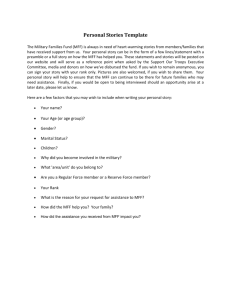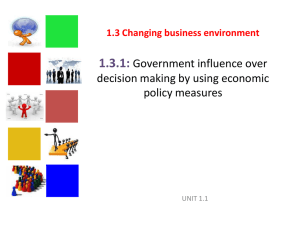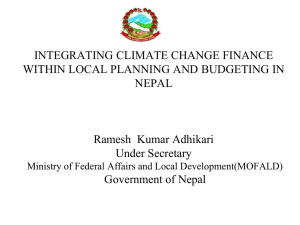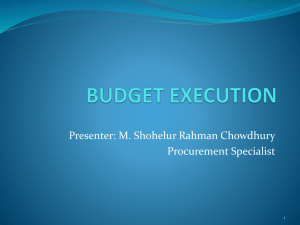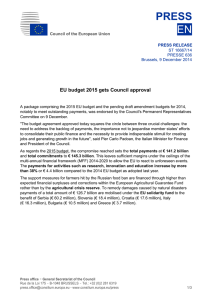Session 2.6 EC - Climate Change Finance and Development
advertisement
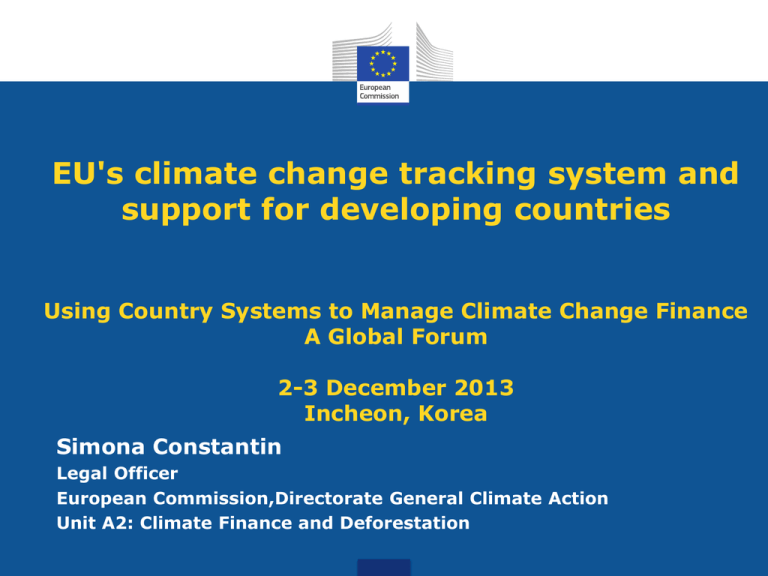
EU's climate change tracking system and support for developing countries Using Country Systems to Manage Climate Change Finance A Global Forum 2-3 December 2013 Incheon, Korea Simona Constantin Legal Officer European Commission,Directorate General Climate Action Unit A2: Climate Finance and Deforestation Overview 1. EU's approach to supporting climate action in the next multi-annual financial framework (MFF) of the EU budget for 2014-2020 1.1 Mainstreaming climate action 1.2 Tracking system for climate expenditure 2. EU's support to developing countries in addressing climate change 2.1 Key facts in 2013 2.2 From 2014 onwards 2 1. EU's approach to supporting climate action in the next multi-annual financial framework (MFF) of the EU budget for 2014-2020 1.1 Mainstreaming climate action 29 June 2011 Commission Communication on a Multiannual Financial Framework (MFF) for 2014-2020: Climate is one of the five headline targets of Europe 2020 strategy– how to reflect this in the budget? •“Mainstreaming”: Climate action objectives “to be reflected in all EU main instruments to ensure that they contribute to building a low-carbon, resource efficient and climate resilient economy”. •Objective to increase the proportion of climate related expenditure to at least 20% in the next EU budget (2014-2020) with contributions from different policies (around €180 billion); •Approach endorsed by the European Council on 8 February 2013 and confirmed by the European Parliament in its resolution of 13 March 3 2013. 1. EU's approach to supporting climate action in the next multi-annual financial framework (MFF) of the EU budget for 2014-2020 1.2 Tracking system for climate expenditure Common tracking system on how much spending in the EU budget relates to climate action; •Approach based on OECD methodology (“Rio markers”) already used by European Commission for international cooperation spending instruments; •All expenditure to be marked in one of the three categories: climate related only (counted as 100%); significantly climate related (counted as 40%); and not climate related (0%); •Methodology integrated in the EC budgetary procedures: link between climate related objectives and outputs and indicators; •Applied to both shared managed (Member States reporting obligations) and centrally managed (European Commission reporting obligations) EU's policies and instruments; •Reporting both ex-ante (indicative budget estimates) and ex-post 4 (spending ). 1. EU's approach to supporting climate action in the next multi-annual financial framework (MFF) of the EU budget for 2014-2020 1.2 Tracking system for climate expenditure Climate tracking in EU Budget 2014 - Overview table •Presentation of all contributing programmes and their relevant specific objectives/outputs with corresponding amounts 5 2. EU's support to developing countries in addressing climate change 2.1 Key facts in 2013 Mobilization of climate finance after 2012: •€7.34 billion 'fast start finance' provided to developing countries for 2010-2012 (€7.2 billion pledged); •Doha announcements (2012): €5.5 billion from EU and a number of Member States of voluntary climate finance contributions to developing countries; on track to deliver this amount in 2013. •Warsaw announcements (2013) • in 2014 at least the same level of climate finance contributions to developing countries as in 2013. • EU's development policy to contribute €1.7 billion for climate spending in developing countries in 2014-2015; • EU Member States have contributed well over half of a US 6 $ 100 million to the Adaptation Fund. 2. EU's support to developing countries in addressing climate change 2.1 Key facts in 2013 Diverse delivery channels (some examples of working together on climate finance and development assistance): • public climate finance supporting the most vulnerable developing countries: • Global Climate Change Alliance (GCCA), EU initiative supporting in particular Least Developed Countries and Small Island Developing States: additional €47 million in 2013; since 2008 supporting more than 45 national and regional programmes across 35 countries and 8 regions and sub regions, with a total budget of close to €300 million. •leveraging climate finance • EU Blending Facilities: since 2007 about €480 million in public grants for more than 200 climate-relevant initiatives; total project financing of more than €14 billion benefiting both low and middle income countries. •financial institutions in the EU (AFD, KfW, EIB) have set themselves operational targets for climate finance as a proportion of their overall investment portfolio (ranging from 50% to 25%, respectively) • in 2013, the European Investment Bank is expected to meet its target of allocating 25% of its planned total lending of €68 billion to climate action. The EIB currently provides between €1.5bn and €2bn per year of climate finance for investments outside the EU. 7 2. EU's support to developing countries in addressing climate change 2.2 From 2014 onwards Continue to use a diversity of instruments and integrate climate change into EU development aid (some examples); •under the Development Cooperation Instrument (DCI), a specific programme for Public Goods and Challenges to allocate significant funding for climate change and environmental objectives. •climate change as a focal area and/or a cross-cutting issue. •climate compatible development (i.e. energy and energy efficiency, green and inclusive economic development, increased resilience). •ensuring aid effectiveness: ownership (supporting developing countries’ agendas), alignement (using country systems – integration in national budgeting and planning, and budget support). •continued and scaled-up financial support to adaptation action through the Global Climate Change Alliance. 8 Further information available Brochure on European Union climate funding for developing countries in 2013 (provisional update) http://ec.europa.eu/clima/events/0086/funding_en.pdf Global Climate Change Alliance http://www.gcca.eu/ Submission on Strategies and Approaches of the EU and its Member States for mobilising scale-up climate finance towards the developed countries’ goal to jointly mobilise USD 100 billion http://unfccc.int/files/documentation/submissions_from_parties/ap plication/pdf/cop_suf_eu_02092013.pdf Fast-start finance by the EU and its Member States: http://ec.europa.eu/clima/policies/finance/international/faststart/i ndex_en.htm Thank you! 9

